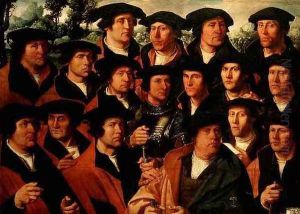Dirck Jakobsz Paintings
Dirck Jakobsz was a Dutch Renaissance painter born in Amsterdam. He was part of a family of artists; his father, Jacob Cornelisz van Oostsanen, was also a well-known painter in Amsterdam during the early 16th century. Dirck's work was influenced by his father's style, as well as by the works of other contemporary artists from the Northern Renaissance.
Dirck Jakobsz's career spanned a period when the Netherlands was experiencing significant changes due to the Protestant Reformation. However, despite the religious turmoil of the period, he mainly focused on secular subjects. He was known for his portraits, a genre that became increasingly popular during the 16th century as the middle class grew and there was a rising demand for personal representation. Jakobsz's portraits were characterized by their detailed representation of the subjects' attire and their unembellished presentation of the sitters' personalities.
In addition to his portraits, Dirck Jakobsz also painted historical scenes and was one of the first artists in the Northern Netherlands to paint large-scale battle scenes. His work often contained vivid detail and a dynamic sense of movement, which was somewhat innovative for the time. Unfortunately, many of his works have not survived or are not attributed to him with certainty, as was common with many artists of the era.
Jakobsz was active in Amsterdam throughout his career, and his works were sought after by the wealthy burghers of the city. He played a significant role in the development of Dutch painting, and his influence can be seen in the works of artists from the later Dutch Golden Age. Dirck Jakobsz died in Amsterdam in the year 1567, leaving behind a legacy that would contribute to the rich tapestry of Dutch art history.
